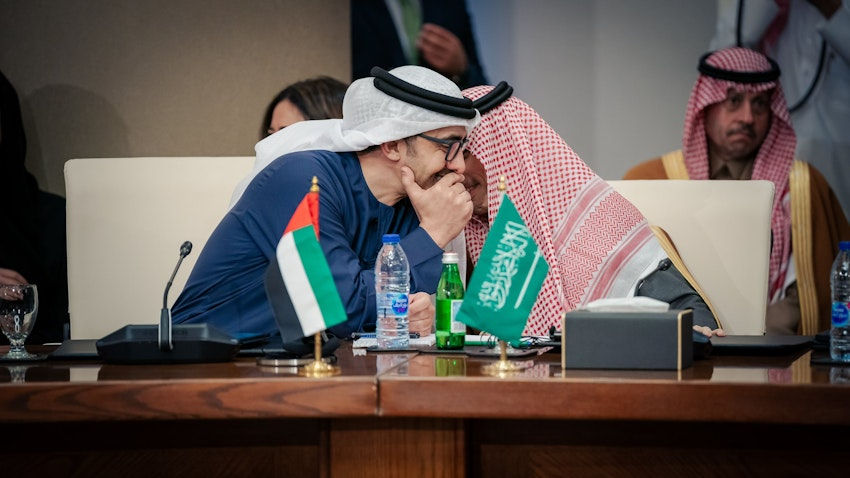Riyadh moves to rewire its global role with AI
- Andreas Krieg
- May 16
- 4 min read
Saudi Arabia aims to translate its hydrocarbon wealth into computational power [The article originally appeared on AGBI]
President Trump leaves the Saudi kingdom with a range of different AI and tech investments in his pocket. Saudi Arabia, long associated with oil-fuelled economic might, intends to make a decisive bet on a different kind of power: data. With $100s billions in announced investments—ranging from AI infrastructure to chip supply deals with Nvidia, AMD, and Qualcomm—Saudi Arabia is not just buying into the AI future; it aims at transforming itself into a central node in the global tech ecosystem. This strategy provides the Kingdom with a new kind of networked strategic leverage; one built not on hydrocarbon but on data flows.
Economic Transformation
The heart of the vision is Humain, a newly launched AI firm backed by the kingdom’s Public Investment Fund (PIF). Humain features prominently in deals to acquire hundreds of thousands of Nvidia’s latest “Blackwell” chips. It is also set to develop massive AI data centres capable of up to 500 megawatts of GPU computing power.
Saudi Arabia is trying to achieve this by capitalizing on an increasingly scarce and vital resource in the AI age: cheap energy. Data centres, especially those running high-intensity AI workloads, are ferociously energy-hungry. The transition to a post-hydrocarbon economy is not about abandoning fossil fuels altogether but about using them more strategically. Saudi Arabia is doing just that—leveraging its comparative advantage in low-cost energy to power AI infrastructure that can anchor the next phase of economic development. The Kingdom is trying to translate its hydrocarbon wealth into computational power.
This pivot is tightly linked to Saudi Arabia’s Vision 2030, a national strategy to diversify the economy, reduce dependency on oil, and transform the Kingdom into a hub of innovation. The AI deals announced during Trump’s visit show how far this vision has come from being a PR slogan. With $80 billion in reciprocal investments from companies like Google, Oracle, and Uber, Riyadh is not only importing technology but exporting capital—demonstrating a new level of ambition to shape the global tech economy.
Yet, despite the ambition and scale, there is a looming question mark over the financial sustainability of the Crown Prince’s AI dream. Global oil prices have remained persistently low—well below Saudi Arabia’s fiscal breakeven threshold, estimated at over $80 per barrel. With oil revenues no longer covering the Kingdom’s expansive spending, Riyadh is increasingly turning to borrowing to fund its Vision 2030 priorities. Even with the PIF's deep pockets, maintaining the pace of investment in AI infrastructure, education, and foreign partnerships will be fiscally demanding. While sovereign debt remains manageable for now, future liquidity constraints or external shocks could force difficult trade-offs between economic transformation and fiscal prudence.
Geo-Strategic Entanglement
The massive Saudi push into the AI space is, however, not just a (geo)economic one but also a geo-strategic one. In the 21st-century strategic order, compute power is national power, and Saudi Arabia is building digital capabilities that rival or exceed those of many advanced economies. In effect, Riyadh is making itself indispensable to the future of global AI, creating deep entanglements with Western tech giants and placing itself in the engine room of digital capitalism.
In an era of great power rivalry, technology is diplomacy, and chip access is leverage. The Trump administration’s easing of Biden-era AI chip export restrictions to the Gulf is not an act of benevolence; it is a recognition of Saudi Arabia’s new value as a trusted technological ally. Riyadh has clearly signalled that it is putting its tech eggs in the U.S. basket—rejecting the Huawei model in favour of Nvidia, AMD, and Qualcomm. This is not merely an economic choice; it is a strategic alignment that deepens bilateral interdependence between Riyadh and Washington.
By entangling itself in U.S. supply chains and playing a central role in the AI ecosystem, Saudi Arabia is binding its future to American technological hegemony. This does not just enhance Riyadh’s access to cutting-edge platforms—it also increases Washington’s stake in the Kingdom’s stability and success. In a transactional world order, this is how trust is built: through interdependence. The Saudis are becoming not just buyers of U.S. technology but enablers of its deployment at scale—especially in the Middle East and Global South, where Washington is eager to counter Chinese digital influence.
In that sense, Saudi Arabia’s AI leap is more than a national project—it is a geo-strategic play. It aims to position the kingdom as a gatekeeper in global data flows, an anchor of digital infrastructure, and a vital ally in the U.S.-led tech bloc. Just as oil once gave Saudi Arabia leverage in a carbon-centric world, AI infrastructure is supposed to provide similar clout in the network-centric world of the 21st century.
Riyadh has always understood the power of being a hub—of oil or religion. Now, it is staking a very ambitious claim to be a hub in global data flows and artificial intelligence. And in so doing, it is borrowing from the playbook of its neighbours in the UAE who are competing in the same space.






Comments